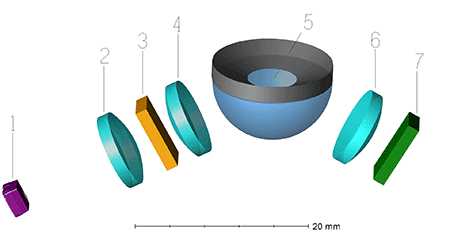Snell's law, also known as the Snell-Descartes law, relates the incidence and refraction angles to the refraction indices of the media involved. As shown in the figure, the law determines that the product of the sine of the angle formed between the ray of light (1), the normal straight line (2) and the refractive index of the media (n1 and n2) must be constant.
n1 sinα = n2 sinβ
The figure shows how a light beam (1, blue arrow) is deflected when it crosses at a certain angle from an optically less dense (n1) to an optically more dense medium (n2), e.g. from air to water.
But when the beam crosses from one medium to another perpendicular to the dotted line, no directional change takes place (green arrow).
Snell's law states that the ratio of the refractive index of each of the media is proportional to the ratio of the incident and refractive angle of the light beam. Therefore:







